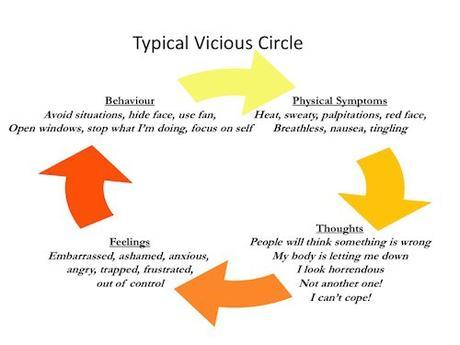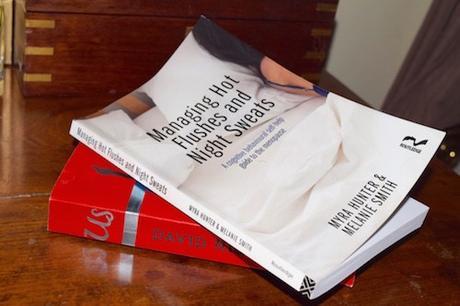
Flame On © lynette sheppard
One of our goddess sisters from across the pond, Lucy Teear, shares this terrific book review with tips for managing hot flashes and night sweats naturally. And do check out Lucy’s blog at Embrace the Change.
Book Review: Managing Hot Flushes & Night Sweats By Myra Hunter & Melanie Smith
by Lucy Teear
Whoa…. My usual chick lit abandoned for two nights in favour of truly engrossing and informative read about the menopause, not something I ever expected to say! The menopause seems to be such a taboo subject, something to be suffered in silence and ever so slightly embarrassing, but this book provides balanced informative which changed my preconceived negative thoughts and the four week self-help guide shared techniques to help manage symptoms that are uplifting and positive.
The Finding of This Holy Grail….
I discovered Myra Hunter and her wonderful book in October whilst attending a “Managing menopausal symptoms following breast cancer treatments” (bit of a mouthful) held by “Breast Cancer Care” support – a fabulous support network that saved my sanity whilst going through chemo.
Having had breast cancer the possibility of HRT is ruled out for me, so resigned to the fact I’d have to go cold turkey and the impact of chemo can make the symptoms more severe than a natural menopause… Explains the hell of the last 3yrs, major hot flushes up to 10 – 15 times plus a day at its peak, then the flooding where my period would last weeks and be so super heavy I’d be jacked up on tampons and pads giving me a cowboy stance!! All in all leaving me feel drained and incredibly miserable. Happy to report I’m in a much more manageable place but still attended like the majority of the women in the room full of hope of discovering a new medical breakthrough, a pill, a drug that would magically alleviate the suffering of the night sweats and hot flushes (now at about 2 a day), but what we covered and discovered was far more powerful and enlightening, resonating with me….
Including:
What is the menopause
Symptoms
Pharmacological approaches to alleviating symptoms
Non-pharmacological approaches (natural remedies etc.)
Cognitive behavioural approaches
Self-help strategies
All the above is covered in detail in a readable and engaging format in the book.
So, we didn’t get the pills and drugs but instead CBT.
So what is “Cognitive Behavioural Therapy (CBT)”:
CBT is a therapy that helps manage problems by enabling you to recognise and ultimately change the way you think and behave in connection with the problem. Combining a cognitive approach with a behavioural approach, CBT encourages you to notice how your thoughts and actions influence one another.
It was clear that most of the women in the room felt the menopause was a taboo topic, something viewed negatively by society and therefore a source of great embarrassment… This is where CBT kicks in, as how we think will ultimately have an effect on how we experience the symptoms – makes sense right?
The below slide highlights the negative thought cycle:

My personal experience with hot flushes are they tend to arrive at the most inconvenient times, an example being a business meeting I had with five guys in a very small room, knowing it was going to be a challenging negotiation I was pretty pumped up and as soon as we started, it started… heat building, sending my pulse racing, panic rising along with the heat “My god they’ll notice” was all I could think, just intensifying the whole darn experience! In reality I’m sure it looked like a normal stress related response to the situation, and had I read this book then my perception would be just that and I’d have handled differently, controlled my breathing and had a very different internal dialogue.
Although a complete rookie yogi, I’m a newbie fan of mediation/mindfulness and often use it to help with the stresses of work (Construction industry is a hive of stress), and hadn’t thought to apply it to menopausal symptoms but having read the book I now see the correlation between the reduction in my flushes and the reduction in stress since practising meditation daily. At the seminar Myra guided us through a paced breathing exercise and calm spread through the room, even the most skeptical looked more relaxed and chilled out!
Right, lets take a look at this book….

Firstly the authors credentials:
Myra Hunter (the speaker above) is professor of clinical health psychology at the Institute of Psychiatry, King’s College London. She’s worked in the area of women’s health for over thirty years and her research on menopause has established her as an international expert in the field…. Knows her stuff for sure.
Melanie Smith is a clinical psychologist who has specialised in helping people to manage physical health conditions through the use of cognitive behavioural therapy. She is currently working with the Manchester and Salford Pain Centre.
The format:
The book covers in more depth what we touched on in the “Breast Cancer Seminar” and is divided into two sections:
Information about the menopause, hot flushes and CBT explained
CBT Self-Help Guide
There’s also download link which provides an audio recording guiding you through a relaxation and breathing exercise, which I love listening to first thing in the morning to set me up for the day, as feel amazingly refreshed and positive after – Also great just before going to bed if you need to let go of the days fuzz buzzing around the mind!
Although both academics this book is clearly written by women for women, the first section shares current knowledge based on really accessible and easy to understand research data, along with the latest information on why we experience hot flushes and night sweats – It’s not all about the hormones! It looks at how different cultures experience the menopause which is fascinating, and makes you consider if society was less judgmental about the ageing process then maybe as women we wouldn’t judge ourselves so harshly and feel the embarrassment quite so deeply!
It covers the principles of CBT, the theory behind how it works and the relationship cycle between: Thought – Feelings – Behavior – Physical reactions and how this cycle impacts on menopause symptoms.
I found it a compelling read and I’m usually more of a fiction gal! Even reading aloud parts with much excitement to Teear (my husband for those who haven’t read my intro)… not sure how much he took in but feigned sufficient interest!
The second part of the book sets out an interactive four-week programme using CBT, exercises and worksheets designed to enable women to develop strategies for managing symptoms. This approach is based on the authors’ research and has been shown to be effective in recent clinical research trials.
The main components of the self guide include:
Being informed about menopause symptoms;
Understanding what can help you cope with your symptoms
Learning steps to use relaxation and paced breathing
Taking steps to reduce general levels of stress
Identifying and modifying triggers of hot flushes
Dealing with negative thoughts and behavioural reactions
Practicing relaxations and breathing at the onset of a flush
Dealing with hot flushes in social situations
managing night sweats and sleep
We’re now embarking on the four week self-help guide, Diane (who’s also reading the book) and I are doing this part together so we can compare notes and we’d like to invite fellow suffers to join in, feeding back your experiences and reviews – If you fancy giving it a go you can buy the book on: https://www.routledge.com/products/9780415625159.
Available also in the US at Amazon: click here.

